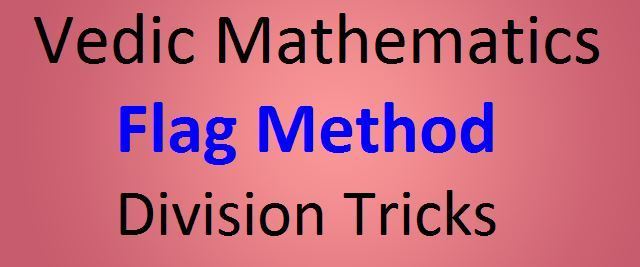Factorization using Vedic Mathematics is done by using 2 Sutras.
Combo Rule (Perfect Quadratic Expression):
We use combination of 2 sutras.
- Anurupyena(Proportionality).
- Adyamadyenantyamantya (1st by 1st and last by last) (explained below):
In Anurupyena, we split the middle term (coefficient of x) of quadratic equation in 2 terms such that Proportion/Ratio of coeff of x2 term to 1st coeff of x term = Ratio of 2nd coeff of x term to constant term. That ratio of the 1st 2 coeff is one of the root of equation.
Adyamadyenantyamantya
In Adyamadyenantyamantya (Commonly called as Adyamadyena), we divide the first term’s coeff of eq with 1st term of factor obtained above and last term of eq with the last term of the same factor.
Sanskrit Name (For Adyamadyenantyamantya):
आद्यमाद्ये नान्त्यमन्त्येन
English Translation (For Adyamadyenantyamantya):
1st by 1st and last by last
Examples:
2x2 + 5x -3
- Anurupyena: Split middle terms coeff(5) in 2 parts such that coeff of x2 term to 1st coeff of x term = Ratio of 2nd coeff of x term to constant term.Hence split it in 6 and -1 (2/6 = -1/-3) => 2x2 + 6x –x -3So 1st factor: x+3 (2:6)
- Adyamadyenantyamantya: Divide the first term’s coeff (2) of eq by 1st term of factor(1) and divide last term of eq (-3) by 2st term of factor (3)So 2nd factor: 2x-1
Similarly,
4x2 + 12x + 5 = (2x+1)(2x+5)
9x2 -15x + 4 = (3x-1)(3x-4)
6x2 + 11x -10 = (2x+5)(3x-2)
Here we come across to another important sutra Gunitasamuccaya Samuccayagunita
Gunitasamuccaya Samuccayagunita
Sanskrit Name:
गुणितसमुच्चयः समुच्चयगुणितः
Commonly called as Gunitasamuccaya.
English Translation:
Product of the sum of the coefficients of the factors = sum of the coefficients in the product.
Example:
4x2 + 12x + 5 = (2x+1)(2x+5)
Sum of the coefficients in the product: 4 + 12 + 5 =21
Product of the sum of the coefficients of the factors: (2+1)(2+5) = 21
Lopana Sthapanabhyam (Subsutra of Adyamadyenantyamantya):
Sanskrit Name:
लोपनस्तापनाभ्याम्
English Translation:
By Alternare Elimination and Retention.
Examples:
1. Factorize 2x2 + 6y2 + 3z2 + 7xy + 11yz + 7zx
We have 3 variables x,y,z.
Applying Lopanasthapana, remove any of the variable. Lets Eliminate z by putting z=0.
Hence the given expression
E = 2x2 + 6y2 + 7xy
= (x+2y) (2x+3y) … (Combination of Anurupyena & Adyamadyenantyamantya).
Similarly, if y=0, then
E = 2x2 + 3z2 + 7zx
= (x+3z) (2x+z)
As x and 2x are present separately and uniquely.Hence we cay map to get Factors.
E = (x+2y+3x) (2x+3y+z)
2. Factorize x2 + xy -2y2 + 2xz -5yz -3z2
Eliminating z and factorizing gives (x-y)(x+2y)
Eliminating y and factorizing gives (x-z)(x+3z)
But as we see x term is present in all factors so we cannot map with correct terms to get factors. So we need the eliminate 3rd variable as well
Eliminating x and factorizing gives (-y-z)(2y+3z)
Now very easily we can do mapping and get E = (x-y-z)(x+2y+3z)
Note:
- We can eliminate 2 variables at a time as well. Thus we will have to map on the basis of Single independent term. But it will have few steps more.
- Lopanasthapana method can also be used for calculating HCF of expressions.
- We can also apply Gunitasamuccaya for checking.
Cubic_Polynomials
Factorization of Cubic Polynomials:
Cubic Polynomial: ax3 + bx2 + cx + d
Initial Step:
- Check a+b+c+d = 0, If sum of all coefficients=0 then directly we say (x-1) is 1 factor. OR
- Check a+c= b+d , If sum of odd terms = sum of even terms then (x+1) is 1 factor
and then apply Paravartya Sutra rule to get a quadratic Equation and apply usual Combo rule of Adyamadyena and Adyamadyena for solving quadratic equation.
Examples:
Solve x3 – 6x2 + 11x -6
- Sum of all coefficients=0 so (x-1) is 1 factor.
- Using Paravatya rule (x3 – 6x2 + 11x -6)/(x-1) gives x2 – 5x + 6
- Solve quadratic equation using Combo Rule to get (x-2)(x-3)
- E = (x-1)(x-2)(x-3).
Solve x3 + 6x2 + 11x +6
- Sum of odd terms = sum of even terms= 12, so (x+1) is 1 factor
- Using Paravatya rule (X3 + 6x2 + 11x +6)/(x+1) gives x2 + 5x + 6
- Solve quadratic equation using Combo Rule to get (x+2)(x+3).
- E = (x+1)(x+2)(x+3).
If none of the Initial steps are satisfied then we apply following approach.
Solve x3 + 12x2 + 44x + 48
- None of the above Initial Condition is satisfied.
- Last term(d) = 48. Factors of 48 are 1,2,3,4,6,8,12,16,24 and 48.
- We need to find 3 numbers of these factors such that their sum = b(12) and product = d(44).
- By trial and error method we observe 2+ 4 + 6 and 2 x 4 x 6 = 48
- So the factors are (x+2)(x+4)(x+6)
Solve x3 -2x2 -23x + 60
- None of the above Initial Condition is satisfied.
- Last term(d) = 60. Factors of 60 are 1,2,3,4,5,6,10,12,15,20,30 and 60.
- We need to find 3 numbers of these factors such that their sum = b(-2) and product = d(60).
- By trial and error method we observe -3 -4 + 5 = -2 and -3 x -4 x 5 = 60.
- So the factors are (x-3)(x-4)(x+5).


how to solve imperfect quadratic expressions